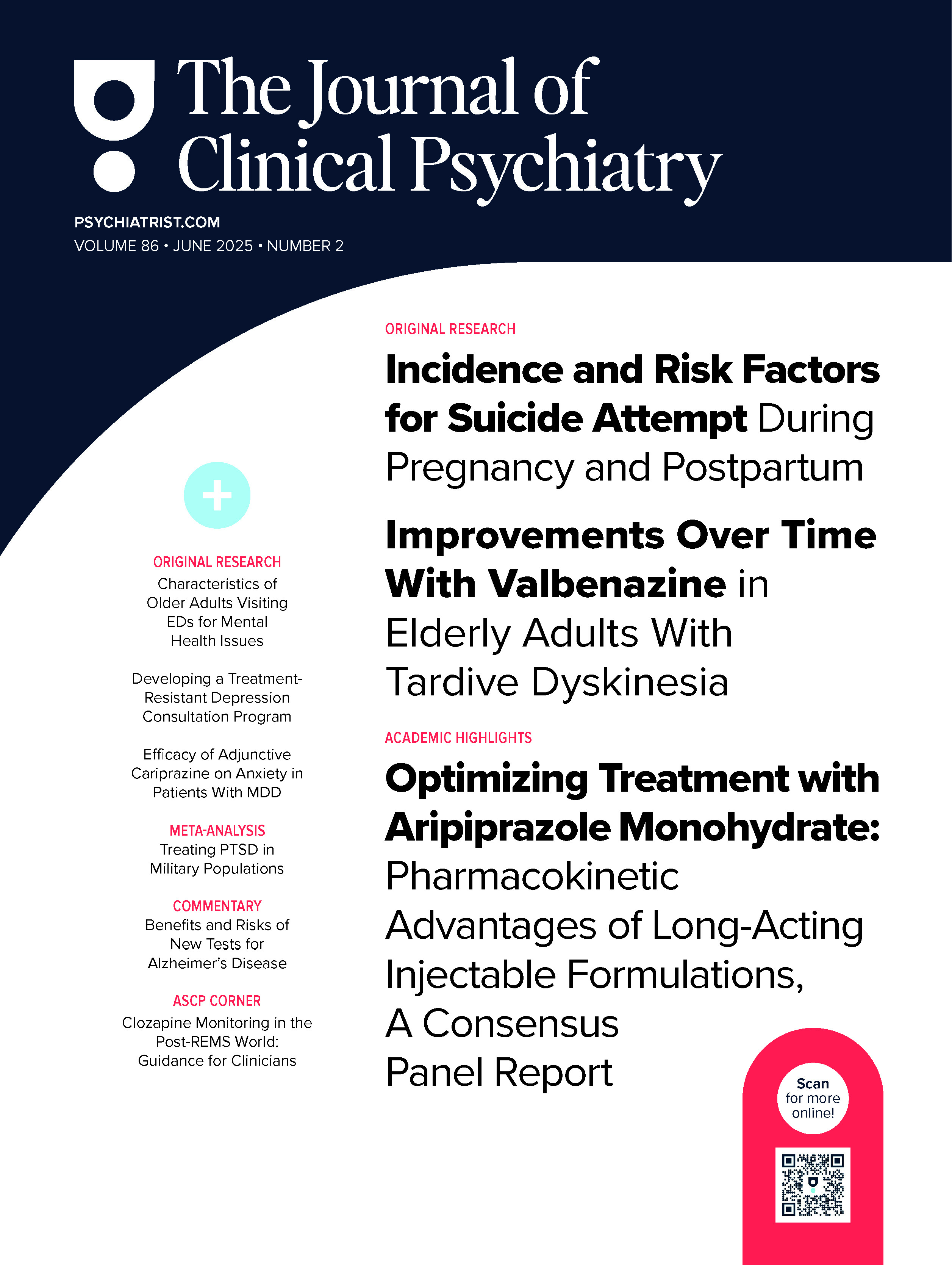See article by Baek et al
Baek et al in this issue of the Journal present results from a longitudinal observational study that aimed to ascertain whether a correlation exists between depressive symptom trajectories and the evolving risk of underweight/ obesity.1 It is a highly replicated finding that a robust, bidirectional, cross-sectional and longitudinal association exists between underweight/obesity and depressive symptoms in both the general and clinical population.2–7 The Baek et al study extends our understanding of this association by identifying subpopulations of depressed persons, defined on the basis of longitudinal symptom severity, and its relationship with body mass index (BMI; kg/m2). The impetus provided by the authors to conduct this research was to reconcile apparently conflicting reports in the extant literature wherein both increased and decreased weight in depressed populations have been observed.
The study’s data source was the Korean Longitudinal Survey of Women and Families (KLoWF) which originated in 2014 and was completed in 2020. It is notable that South Korea has the highest rate of death by suicide of any member nation within the Organization for Economic Cooperation and Development.8 The target population of the KLoWF was Korean women aged 19–64 years. A total of 7,691 participants completed the 2014 survey, while 6,196 participants completed the 2020 survey, representing 27,488 observations across a mean 3.45 number of visits per participant. Depressive symptoms were measured with the 10-item Center for Epidemiologic Studies Depression Scale (CESD 10) Korean Version. Obesity and underweight were operationalized as follows: Class I obesity, 25 kg/m2 ≤ BMI < 30 kg/m2; Class II obesity, BMI ≥ 30 kg/m2; and underweight, BMI < 18.5 kg/m2.
Using growth mixture models, 5 separate depression subgroups (ie, classes) were identified. Of the 5 subgroups identified, persons (N = 279; 3.6%) with persistently high levels of depressive symptoms (CESD-10 score > 10) exhibited an increased adjusted odds ratio (OR) for underweight from 2014 to 2020 from 2.27 (95% CI, 1.32–3.92) to 3.39 (95% CI, 1.91–6.05). In addition, this subgroup was at increased risk for Class II obesity at the 2020 evaluation (OR [95% CI], 3.76 [1.97–7.17]).
This thoughtful analysis by Baek et al has “fit for purpose” implications for clinical practice and raises many interesting questions with respect to mechanistic translational research and treatment discovery. From a clinical perspective, the Baek et al study reminds practitioners that persons living with depressive symptoms are differentially affected by clinically meaningful changes in BMI.9,10 The novelty of the Baek et al study is the granularity that has been provided insofar as they identified a subgroup of persons with severe persistent depression who were especially susceptible to BMI shifting, warranting a personalized approach with respect to medical risk assessment and care planning.11
Their results further augment the evidentiary base that has supported recommendations for the routine assessment of diet, lifestyle, exercise and overall activity, sleep patterns and comorbidity associated with weight change (eg, binge eating disorder, attention-deficit/hyperactivity disorder, and alcohol and/or substance use disorder) as well as BMI and weight-related metabolic comorbidity in all depressed patients.11,12 Notwithstanding these recommendations, it is disquieting that results from implementation science surveys in psychiatry indicate that most persons with severe persistent illness are not being routinely monitored for metabolic aspects, a modifiable quality of care gap.13–15 In addition, the greater propensity to clinically meaningful BMI shifting in the severe persistent depression group assigns a higher level of priority to psychotropic drug selection that is less likely to significantly alter body weight and metabolism.16
A separate clinical consideration, which I inferred from the Baek et al study, is that persons with persistently high depressive symptoms and underweight/obesity may be at a higher risk for suicidal ideation and suicide attempts as well as death by suicide. In addition to depression being highly associated with suicidality, replicated and convergent evidence also has documented an association between underweight as well as obesity with suicidality.17,18 A separate line of research has also reported a further increased risk for suicidality in persons living with mood disorders and comorbid obesity when compared to persons with mood disorders who are not obese.19
I have noticed, in accordance with published literature, in my own patients living with depressive or bipolar disorders that general cognitive impairment and aspects of anhedonia are more pronounced when they are either underweight or obese.20,21 It could be conjectured that the increased risk for suicide in persons with severe persistent depression and comorbid underweight/obesity is partially mediated by cognitive impulsivity and greater impairment in reward function (notably anticipatory anhedonia).22–27 The link between depressive symptoms, underweight/ obesity, general cognitive impairment and anhedonia instantiates the mechanistic “metastasis” of obesity to the brain.28,29
From the perspective of mechanistic translational research and treatment discovery, the Baek et al study reminded me of the future research pathway in the development of precise innovative therapeutics in psychiatry. It is a priority research vista in psychiatry to identify mechanistic pathways and hierarchical systems that subserve the surface-based phenomenology encountered clinically. Therapeutic advances in other areas of medicine (eg, cancer) are paradigmatic of the innovation that is possible with therapeutic discovery and development when mechanistically informed approaches are the strategic priority.
The overarching barrier to identifying mechanistically informed and disease-modifying therapies in psychiatry is the incomplete understanding of the causal mechanisms and disease pathogenesis. Depressive disorders are (like all mental disorders) highly heterogeneous with respect to causation, pathoetiology, illness trajectory and response to treatment. Although once considered monocausal, depressive disorders are now conceptualized as multicausal, probabilistic rather than deterministic, and dynamic rather than static phenotypically and biologically throughout the illness trajectory.30 A single encompassing explanatory mechanistic model of depressive disorders would certainly cater to our appetite for simplicity and brevity but would also strain credulity and validity.
A strategic approach to the aforementioned challenge of heterogeneity is to subphenotype mood disorder populations on the basis of observable characteristics and biomarkers/biosignature (ie, phenobiotype).11,31 For example, persons with depressive disorders may be subtyped on the basis of phenotypic (eg, anhedonia, general cognitive impairment, and underweight/obesity) and/or illness course characteristics (eg, longitudinal symptom severity). A subphenotyping approach identifies “latent” subpopulations with less neurobiological heterogeneity, which is sine qua non for parsing underlying neurobiological mechanisms relevant to the disease process.
For example, one could conjecture that the subpopulations in the Baek et al study with severe persistent depression were more likely to evince alterations in sympathetic and hypothalamic pituitary-adrenal activity, proinflammatory imbalance and/or insulin-glucose dysregulation.32–46 If so, this might implicate a subpopulation of adults with depression as having a phenotype that is best conceptualized as a “metabolic inflammatory” depression.39 A derivative of these observations and assumptions is that treatment discovery and development for depressive disorders could involve de novo or repurposed drugs that heretofore have been implemented in persons with metabolic and/or inflammatory disorders.
For example, glucagon-like peptide-1 (GLP-1) is a protein produced by L-cells of the intestine, as well as in neurons located in the nucleus tractus solitarius. In addition to increasing insulin biosynthesis and release in response to an oral glucose load, GLP-1 decreases glucagon, gastric motility and appetitive drive.47 GLP-1 receptor agonists (GLP-1 RAs) are approved as glucose-lowering agents and for weight management in persons who are overweight with associated metabolic morbidity, or obese. In addition to their effects on metabolics and weight, GLP-1 and GLP-1 RAs are nerve growth factors that have been shown to increase dendritic length, branching, and complexity as well as augment neuroplasticity via glutamatergic, monoaminergic, anti-inflammatory, and antioxidative pathways.48–51
Available evidence also indicates that GLP-1 RAs may also selectively target brain regions implicated in both obesity and depression. For example, the habenula, also known as the “antireward” center, is implicated in the pathogenesis of depressive disorders and obesity and is also a region targeted by GLP-1 RAs.52,53 A separate observation is that GLP-1 RAs exert effects on brain connectome relevant to both depressive disorders and obesity.54 The combined GLP-1/glucose insulinotropic polypeptide (GIP) receptor agonist (ie, tirzepatide) may result in more pronounced weight loss relative to GLP-1 RAs, and separately, it has been shown that GIP has direct neurotrophic effects in the brain.55
The foregoing concatenation of study findings with GLP-1 RAs may provide some understanding of the mechanisms mediating the reduction of depressive symptoms and cognitive dysfunction reported in persons prescribed these agents principally for a metabolic disorder or obesity.56,57 The separate observation that GLP-1 RAs are brain-penetrant provides the basis for repurposing these agents in the prevention and/or treatment of psychiatric disorders, including depressive disorders, major neurocognitive disorders (eg, Alzheimer disease), Parkinson disease, traumatic brain injury and alcohol use disorders.56,58
As with all studies, there are methodologic aspects to the Baek et al study that affect inferences and interpretations of their findings. I did wonder whether potential anamnestic factors, notably childhood adversity and trauma, may have been an antecedent cascade event igniting biological processes that predispose and portend the symptom trajectories that were observed (ie, severe persistent depression) as well as underweight/ obesity.59 In addition, data were not available with respect to symptom profiles of the participants and its potential association with change in BMI. Replicated evidence indicates that atypical depressive symptoms, notably increased appetite, and food consumption in persons with depression have a greater association with anthropometric change and may have a distinct neurobiological mechanism.35,36,60
A further consideration is whether the change in BMI observed by Baek et al may have been in part a consequence of psychotropic drug exposure. My own observation clinically, and shared by many others, is that persons with more severe persistent depression are much more likely to find themselves in a futile therapeutic odyssey of exposure to often inadequate, weight gain–promoting psychotropic drugs, especially when their illness is much more resistant to monoaminergic agents.16
A separate but related consideration is that persons who are underweight/obese are more likely to evince lower remission rates when prescribed selective serotonin reuptake inhibitors when compared to persons who are normal weight. With this in mind, I wondered whether some of the persons in the Baek et al study in the severe persistent depression group were treatment-resistant to monoaminergic drugs which predisposed polypharmacy. Indeed, treatment-resistant depression (TRD) is much more likely to be observed in persons with obesity, and conversely, the risk for obesity and associated morbidity is significantly more likely to manifest after the diagnosis of TRD.12,61
Psychiatry has entered a very exciting and hopeful time. Rather than depending on serendipitous observations as our strategy for therapeutic discovery and development, the field is identifying therapeutics on the basis of phenobiotypes and postulated mechanisms of disease. For example, the N-methyl-D-aspartate receptor antagonist esketamine for TRD and depression at imminent risk for suicide, the γ-aminobutyric acid positive allosteric modulators brexanolone and zuranolone for postpartum depression, and dual orexin receptor antagonists suvorexant, lemborexant, and daridorexant as well as the anti amyloid-β lecanemab for the treatment of cognitive impairment in Alzheimer disease represent examples of clinically available mechanistically informed therapeutics in psychiatry.62–66
In addition to these examples, there are many other innovative therapeutic strategies for psychiatric disorders that are in early-late-stage development that are targeting systems known to be mechanistically mediating psychopathology [eg, κ-opioid receptor antagonists, potassium voltage-gated channel subfamily Q (KCNQ) openers, and selective orexin-1 receptor antagonists].67 It is my hope that this innovative approach, which begins with careful phenobiotyping, will end the waiting for so many persons living with depressive disorders looking to have their life back.
Article Information
Published Online: June 3, 2024. https://doi.org/10.4088/JCP.24com15322
© 2024 Physicians Postgraduate Press, Inc.
J Clin Psychiatry 2024;85(2):24com15322
Submitted: February 27, 2024; accepted February 29, 2024.
To Cite: McIntyre RS. The co-occurrence of depression and obesity: implications for clinical practice and the discovery of targeted and precise mechanistically informed therapeutics. J Clin Psychiatry.2024;85(2):24com15322.
Author Affiliations: Department of Psychiatry, University of Toronto, Toronto, Canada; Department of Pharmacology, University of Toronto, Toronto, Canada; Brain and Cognition Discovery Foundation, Toronto, Canada.
Corresponding Author: Roger S. McIntyre, MD, FRCPC, Brain and Cognition Discovery Foundation, 77 Bloor St W, Ste 617, Toronto, ON M5S 1M2, Canada ([email protected]).
Relevant Financial Relationships: Dr McIntyre has received research grant support from CIHR/GACD/ National Natural Science Foundation of China and the Milken Institute and speaker/consultation fees from Lundbeck, Janssen, Alkermes, Neumora Therapeutics, Boehringer Ingelheim, Sage, Biogen, Mitsubishi Tanabe, Purdue, Pfizer, Otsuka, Takeda, Neurocrine, NeuraWell, Sunovion, Bausch Health, Axsome, Novo Nordisk, Kris, Sanofi, Eisai, Intra-Cellular, NewBridge Pharmaceuticals, Viatris, AbbVie, and atai Life Sciences. He is a CEO of Braxia Scientific Corp.
Funding/Support: None.
References (67)

- Baek SU, Lee YM, Won JU, et al. Longitudinal trajectories of depressive symptoms and their associations with risks of underweight and obesity in women: a population-based longitudinal study in Korea. J Clin Psychiatry. 2024;85(2):24m15247.
- Pereira-Miranda E, Costa PRF, Queiroz VAO, et al. Overweight and obesity associated with higher depression prevalence in adults: a systematic review and meta-analysis. J Am Coll Nutr. 2017;36(3):223–233. PubMed
- Luppino FS, de Wit LM, Bouvy PF, et al. Overweight, obesity, and depression: a systematic review and meta-analysis of longitudinal studies. Arch Gen Psychiatry. 2010;67(3):220–229. PubMed CrossRef
- Silva DA, da Silva Freire Coutinho E, Ferriani LO, et al. Depression subtypes and obesity in adults: a systematic review and meta-analysis. Obes Rev. 2020;21(3):e12966. PubMed CrossRef
- Jokela M, Laakasuo M. Obesity as a causal risk factor for depression: systematic review and meta analysis of Mendelian Randomization studies and implications for population mental health. J Psychiatr Res. 2023;163:86–92. PubMed CrossRef
- Jung SJ, Woo HT, Cho S, et al. Association between body size, weight change and depression: systematic review and meta-analysis. Br J Psychiatry. 2017;211(1):14–21. PubMed CrossRef
- Jawad MY, Meshkat S, Tabassum A, et al. The bidirectional association of nonalcoholic fatty liver disease with depression, bipolar disorder, and schizophrenia. CNS Spectr. 2023;28(5):541–560. PubMed CrossRef
- U.S. Department of Health and Human Services. Social connection — current priorities of the U.S. Surgeon General. Accessed February 14, 2024. https://www.hhs.gov/surgeongeneral/priorities/connection/index.html
- Jantaratnotai N, Mosikanon K, Lee Y, et al. The interface of depression and obesity. Obes Res Clin Pract. 2017;11(1):1–10.
- Liu YK, Ling S, Lui LMW, et al. Prevalence of type 2 diabetes mellitus, impaired fasting glucose, general obesity, and abdominal obesity in patients with bipolar disorder: a systematic review and meta analysis. J Affect Disord. 2022;300:449–461. PubMed CrossRef
- Maj M, Stein DJ, Parker G, et al. The clinical characterization of the adult patient with depression aimed at personalization of management. World Psychiatry. 2020;19(3):269–293. PubMed CrossRef
- McIntyre RS, Alsuwaidan M, Baune BT, et al. Treatment-resistant depression: definition, prevalence, detection, management, and investigational interventions. World Psychiatry. 2023;22(3):394–412. PubMed CrossRef
- Morris ZS, Wooding S, Grant J. The answer is 17 years, what is the question: understanding time lags in translational research. J R Soc Med. 2011;104(12):510–520. PubMed CrossRef
- Laugharne J, Waterreus AJ, Castle DJ, et al. Screening for the metabolic syndrome in Australia: a national survey of psychiatrists’ attitudes and reported practice in patients prescribed antipsychotic drugs. Australas Psychiatry. 2016;24(1):62–66. PubMed CrossRef
- Michael S, MacDonald K. Improving rates of metabolic monitoring on an inpatient psychiatric ward. BMJ Open Qual. 2020;9(3):e000748. PubMed CrossRef
- McIntyre RS, Kwan ATH, Rosenblat JD, et al. Psychotropic drug-related weight gain and its treatment. Am J Psychiatry. 2024;181(1):26–38. PubMed CrossRef
- Haynes A, Kersbergen I, Sutin A, et al. Does perceived overweight increase risk of depressive symptoms and suicidality beyond objective weight status? a systematic review and meta-analysis. Clin Psychol Rev. 2019;73:101753. PubMed CrossRef
- Cabanas-Sánchez V, Yu T, Rodríguez-Artalejo F, et al. Weight loss as a risk factor for suicide. A prospective cohort study in more than 200,000 adults. Obes Res Clin Pract. 2023;17(3):269–270. PubMed
- Fagiolini A, Kupfer DJ, Rucci P, et al. Suicide attempts and ideation in patients with bipolar I disorder. J Clin Psychiatry. 2004;65(4):509–514. PubMed CrossRef
- Bora E, McIntyre RS, Ozerdem A. Neurococognitive and neuroimaging correlates of obesity and components of metabolic syndrome in bipolar disorder: a systematic review. Psychol Med. 2019;49(5):738–749. PubMed CrossRef
- McIntyre RS, Cha DS, Soczynska JK, et al. Cognitive deficits and functional outcomes in major depressive disorder: determinants, substrates, and treatment interventions. Depress Anxiety. 2013;30(6):515–527. PubMed CrossRef
- Gillissie ES, Le GH, Rhee TG, et al. Evaluating Anhedonia as a risk factor in suicidality: a meta analysis. J Psychiatr Res. 2023;158:209–215. PubMed CrossRef
- Amiri S, Behnezhad S. Body mass index and risk of suicide: a systematic review and meta-analysis. J Affect Disord. 2018;238:615–625. PubMed CrossRef
- Bruno S, Anconetani G, Rogier G, et al. Impulsivity traits and suicide related outcomes: a systematic review and meta-analysis using the UPPS model. J Affect Disord. 2023;339:571–583. PubMed CrossRef
- Daneshmand M, Kashefizadeh M, Soleimani M, et al. Network analysis of depression, cognitive functions, and suicidal ideation in patients with diabetes: an epidemiological study in Iran. Acta Diabetol. Published online February 16, 2024. doi: 10.1007/s00592-024-02234-z CrossRef
- Mansur RB, Subramaniapillai M, Zuckerman H, et al. Effort-based decision-making is affected by overweight/obesity in major depressive disorder. J Affect Disord. 2019;256:221–227. PubMed CrossRef
- Raghanti MA, Miller EN, Jones DN, et al. Hedonic eating, obesity, and addiction result from increased neuropeptide Y in the nucleus accumbens during human brain evolution. Proc Natl Acad Sci U S A. 2023;120(38):e2311118120. PubMed CrossRef
- McIntyre RS, Rong C, Mansur RB, et al. Does obesity and diabetes mellitus metastasize to the brain? “Metaboptosis” and implications for drug discovery and development. CNS Spectr. 2019;24(5):467–469. PubMed
- McIntyre RS. Surrogate markers of insulin resistance in predicting major depressive disorder: metabolism metastasizes to the brain. Am J Psychiatry. 2021;178(10):885–887. PubMed CrossRef
- Kendler KS. From many to one to many-the search for causes of psychiatric illness. JAMA Psychiatry. 2019;76(10):1085–1091. PubMed
- McIntyre RS, Alda M, Baldessarini RJ, et al. The clinical characterization of the adult patient with bipolar disorder aimed at personalization of management. World Psychiatry. 2022;21(3):364–87. PubMed CrossRef
- McIntyre RS, Cha DS, Jerrell JM, et al. Obesity and mental illness: implications for cognitive functioning. Adv Ther. 2013;30(6):577–588. PubMed CrossRef
- McIntyre RS. Is obesity changing the phenotype of bipolar disorder from predominately euphoric toward mixed presentations? Bipolar Disord. 2018;20(8):685–686. PubMed CrossRef
- Petri E, Bacci O, Barbuti M, et al. Obesity in patients with major depression is related to bipolarity and mixed features: evidence from the BRIDGE-II-Mix study. Bipolar Disord. 2017;19(6):458–64. PubMed CrossRef
- Lamers F, Milaneschi Y, de Jonge P, et al. Metabolic and inflammatory markers: associations with individual depressive symptoms. Psychol Med. 2018;48(7):1102–1110. PubMed CrossRef
- Milaneschi Y, Lamers F, Peyrot WJ, et al. Genetic association of major depression with atypical features and obesity-related immunometabolic dysregulations. JAMA Psychiatry. 2017;74(12):1214–1225. PubMed CrossRef
- Hamer JA, Testani D, Mansur RB, et al. Brain insulin resistance: a treatment target for cognitive impairment and anhedonia in depression. Exp Neurol. 2019;315:1–8. PubMed CrossRef
- Rosenblat JD, Cha DS, Mansur RB, et al. Inflamed moods: a review of the interactions between inflammation and mood disorders. Prog Neuropsychopharmacol Biol Psychiatry. 2014;53:23–34. PubMed CrossRef
- McIntyre RS, Soczynska JK, Konarski JZ, et al. Should depressive syndromes be reclassified as “metabolic syndrome type II”? Ann Clin Psychiatry. 2007;19(4):257–264. PubMed
- Milaneschi Y, Simmons WK, van Rossum EFC, et al. Depression and obesity: evidence of shared biological mechanisms. Mol Psychiatry. 2019;24(1):18–33. PubMed CrossRef
- Gill H, McIntyre RS, Hawco C, et al. Evaluating the neural substrates of effort-expenditure for reward in adults with major depressive disorder and obesity. Psychiatry Res Neuroimaging. 2023;329:111592. PubMed CrossRef
- Zhang X, Han L, Lu C, et al. Brain structural and functional alterations in individuals with combined overweight/obesity and mood disorders: a systematic review of neuroimaging studies. J Affect Disord. 2023;334:166–179. PubMed CrossRef
- Salzwedel AP, Gao W, Andres A, et al. Maternal adiposity influences neonatal brain functional connectivity. Front Hum Neurosci. 2018;12:514. PubMed CrossRef
- McWhinney SR, Abé C, Alda M, et al. Diagnosis of bipolar disorders and body mass index predict clustering based on similarities in cortical thickness-ENIGMA study in 2436 individuals. Bipolar Disord. 2022;24(5):509–520. PubMed CrossRef
- Kuswanto CN, Sum MY, Yang GL, et al. Increased body mass index makes an impact on brain white matter integrity in adults with remitted firstepisode mania. Psychol Med. 2014;44(3):533–541. PubMed CrossRef
- Cho IY, Chang Y, Sung E, et al. Depressive symptoms and risk of liver-related mortality in individuals with hepatitis B virus infection: a cohort study. Sci Rep. 2020;10(1):20812. PubMed CrossRef
- Drucker DJ, Holst JJ. The expanding incretin universe: from basic biology to clinical translation. Diabetologia. 2023;66(10):1765–1779. PubMed CrossRef
- Marquard J, Stirban A, Schliess F, et al. Effects of dextromethorphan as add-on to sitagliptin on blood glucose and serum insulin concentrations in individuals with type 2 diabetes mellitus: a randomized, placebo-controlled, double-blinded, multiple crossover, single-dose clinical trial. Diabetes Obes Metab. 2016;18(1):100–103. PubMed CrossRef
- Cai X, She M, Xu M, et al. GLP-1 treatment protects endothelial cells from oxidative stress-induced autophagy and endothelial dysfunction. Int J Biol Sci. 2018;14(12):1696–1708. PubMed CrossRef
- Scisciola L, Rizzo MR, Cataldo V, et al. Incretin drugs effect on epigenetic machinery: new potential therapeutic implications in preventing vascular diabetic complications. FASEB J. 2020;34(12):16489–16503. PubMed CrossRef
- Sourris KC, Ding Y, Maxwell SS, et al. Glucagon like peptide-1 receptor signaling modifies the extent of diabetic kidney disease through dampening the receptor for advanced glycation end products induced inflammation. Kidney Int. 2024;105(1):132–149. PubMed CrossRef
- Tuesta LM, Chen Z, Duncan A, et al. GLP-1 acts on habenular avoidance circuits to control nicotine intake. Nat Neurosci. 2017;20(5):708–716. PubMed CrossRef
- Ely BA, Stern ER, Kim JW, et al. Detailed mapping of human habenula resting-state functional connectivity. Neuroimage. 2019;200:621–634. PubMed CrossRef
- Chen VCH, Liu YC, Chao SH, et al. Brain structural networks and connectomes: the brain-obesity interface and its impact on mental health. Neuropsychiatr Dis Treat. 2018;14:3199–3208. PubMed CrossRef
- Fontanella RA, Ghosh P, Pesapane A, et al. Tirzepatide prevents neurodegeneration through multiple molecular pathways. J Transl Med. 2024;22(1):114. PubMed CrossRef
- Cooper DH, Ramachandra R, Ceban F, et al. Glucagon-like peptide 1 (GLP-1) receptor agonists as a protective factor for incident depression in patients with diabetes mellitus: a systematic review. J Psychiatr Res. 2023;164:80–89. PubMed
- Anna Miller RN, Joyce B, Kersten Bartelt RN, et al. Most GLP-1 medications correlated with a lower likelihood of anxiety and depression diagnoses. Accessed February 14, 2024. https://www.epicresearch.org/articles/most-glp1-medications-correlated-with-a-lowerlikelihood-of-anxiety-and-depression-diagnoses
- Klausen MK, Jensen ME, Møller M, et al. Exenatide once weekly for alcohol use disorder investigated in a randomized, placebo-controlled clinical trial. JCI Insight. 2022;7(19):e159863. PubMed CrossRef
- McIntyre RS, Soczynska JK, Liauw SS, et al. The association between childhood adversity and components of metabolic syndrome in adults with mood disorders: results from the International Mood Disorders Collaborative Project. Int J Psychiatry Med. 2012;43(2):165–177. PubMed CrossRef
- Milaneschi Y, Lamers F, Bot M, et al. Leptin dysregulation is specifically associated with major depression with atypical features: evidence for a mechanism connecting obesity and depression. Biol Psychiatry. 2017;81(9):807–814. PubMed CrossRef
- Grigolon RB, Trevizol AP, Gerchman F, et al. Is obesity a determinant of success with pharmacological treatment for depression? a systematic review, meta-analysis and meta regression. J Affect Disord. 2021;287:54–68. PubMed
- McIntyre RS, Rosenblat JD, Nemeroff CB, et al. Synthesizing the evidence for ketamine and esketamine in treatment-resistant depression: an international expert opinion on the available evidence and implementation. Am J Psychiatry. 2021;178(5):383–399. PubMed CrossRef
- Cha DS, Kleine N, Teopiz KM, et al. The efficacy of zuranolone in postpartum depression and major depressive disorder: a review & number needed to treat (NNT) analysis. Expert Opin Pharmacother. 2024;25(1):5–14. PubMed
- Meltzer-Brody S, Colquhoun H, Riesenberg R, et al. Brexanolone injection in post-partum depression: two multicentre, double-blind, randomised, placebo-controlled, phase 3 trials. Lancet. 2018;392(10152):1058–1070. PubMed CrossRef
- Xue T, Wu X, Chen S, et al. The efficacy and safety of dual orexin receptor antagonists in primary insomnia: a systematic review and network meta-analysis. Sleep Med Rev. 2022;61:101573. PubMed CrossRef
- van Dyck CH, Swanson CJ, Aisen P, et al. Lecanemab in early Alzheimer’s disease. N Engl J Med. 2023;388(1):9–21. PubMed
- Cao B, Xu J, Li R, et al. Interventions targeting comorbid depression and overweight/obesity: a systematic review. J Affect Disord. 2022;314:222–232. PubMed CrossRef
This PDF is free for all visitors!




